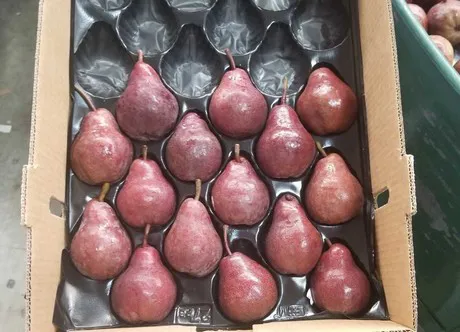Harvesting of California pears is at its peak right now and so far, volume and quality are meeting expectations. Pear growers have enjoyed relatively good growing conditions, with none of the problems that have plagued other California crops earlier in the summer. Bartletts are peaking now and Bosc is following this week, with a month left to go of the harvest.
"We are in the middle of the pear harvest in the Sacramento Delta and we are also starting to see some fruit coming out of Lake and Mendocino counties," shared Kyle Persky of Rivermaid Trading Company. "At this stage, we are on track to hit our pre-season estimate of 1.2 million packed boxes for Sacramento County Bartletts. With Lake and Mendocino added, the total industry estimate is just over 2.2 million. Growing conditions have been very good, the fruit is finishing clean and sizing is good."
Persky said that once the harvest is finished, growers will work through the resultant storage crop, which should last through most of October.

Organic Bosc starting this week
Organic California Bosc pears are right behind their conventional counterparts, with some organic Bosc starting to be harvested this week. Most of the organic volume is made up of Bartlett pears - which have already been harvested - but Bosc is also readily available. Rivermaid Trading Company recently increased organic volume, and it also carries other conventional varieties.
"We added organic Bartlett and Bosc pear volume this year," Persky said. "On the conventional side, we also have red pears available throughout the season, including Starkrimson and Rivermaid Red. Sacramento River Bartletts have the distinction of being 'America's First Pear', with the region being the first in the United States to harvest pears for the season."

Import quality affecting demand
Although growing conditions have been good and pear growers in California are pleased with the quality of the fruit they are harvesting, the market has not been very supportive. According to Persky, there were still a number of imported and storage pears in the market when California began, which impacted pricing. He also said that demand has been affected by the quality of the imported fruit.
"There was a lot of impact on the market from storage and imports, with imports particularly having a detrimental effect on consumption. The imported fruit is treated with 1-MCP. This treatment inhibits ethylene production so when Bartletts do start to turn color, they do not ripen (soften and sweeten) like they normally would. These pears just don't carry the flavor of a piece of fruit that has been ripened naturally on the tree and this impacts consumer perception."
Persky added, "We make a lot of effort here in California with our ripening and conditioning in order to deliver a pear that is naturally sweet and full of flavor and one that consumers will come back and purchase again."

Bagging technology upgraded
Suppliers are continuing to see a trend towards bagged pears, particularly for smaller and medium sized fruit. As a result, companies like Rivermaid Trading Company continue to upgrade equipment to meet the needs of the market.
"We are always looking at more bagged options," Persky explained. "For example, we now offer many different pouch bag sizes and configurations. We have also recently installed new bagging machinery with greater automation capabilities. This is to keep up with what is being observed in the market as demand increases for more bagged pears."
He also noted that the increasing segment of online sales is contributing to a greater utilization of bagged pears. "When it comes to online sales, consumers do not purchase bulk pears. Instead, pears come in units of say 2lb or 3lb. This further increases the demand for bag options."
For more information:
Kyle Persky
Rivermaid Trading Company
Ph: +1 (209) 369-3586
[email protected]
www.rivermaid.com
